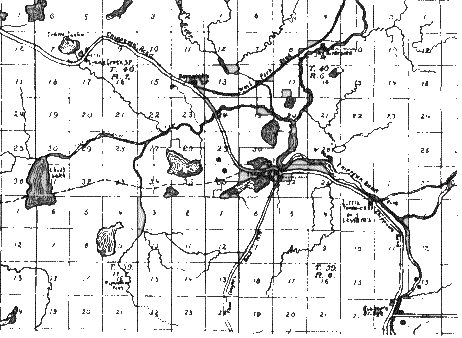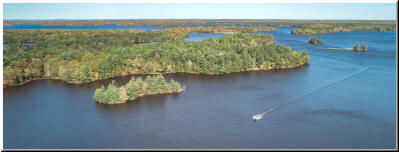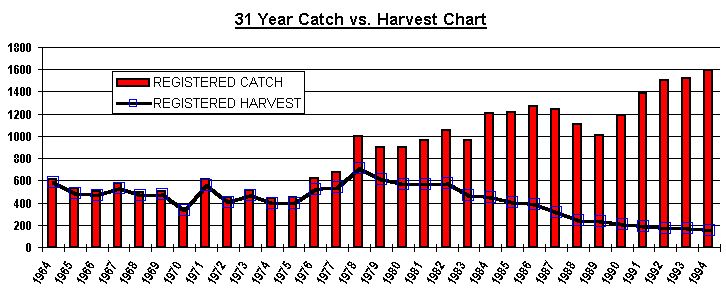Creating A Musky Factory...THE CHIPPEWA FLOWAGE
By: John Dettloff © 1995
 Some one hundred centuries ago, after the retreat of the glaciers
signaled the end of the Ice Age, after our region's landscape was finally free of its
seemingly eternal, thick layer of ice - nature finally made amends by leaving us thousands
of little glacial lakes scattered throughout our north country.
Some one hundred centuries ago, after the retreat of the glaciers
signaled the end of the Ice Age, after our region's landscape was finally free of its
seemingly eternal, thick layer of ice - nature finally made amends by leaving us thousands
of little glacial lakes scattered throughout our north country.
Eleven of
these sparkling blue jewels (Crane, Chief, Tyner, Rice, Scott, Two Boys,
Pokegama, Desire,
Pakwawang and Cranberry Lake) were left to us in close proximity to the valley of the
Chief  River and the West Fork of the Chippewa River, about 20 miles southeast of Hayward
Wisconsin. It must have been during the late 1700's, when these waters first served as
home to the Ojibwa (or Anishinaabeg, as they called themselves). Wanting to establish a
settlement beyond the Lac Coutereille village, they chose the area near the big bend of
the West Fork of the Chippewa River in which to establish the village of
Pah-qua-uah-wong.
River and the West Fork of the Chippewa River, about 20 miles southeast of Hayward
Wisconsin. It must have been during the late 1700's, when these waters first served as
home to the Ojibwa (or Anishinaabeg, as they called themselves). Wanting to establish a
settlement beyond the Lac Coutereille village, they chose the area near the big bend of
the West Fork of the Chippewa River in which to establish the village of
Pah-qua-uah-wong.
Abundant with water and wild rice beds, this prime ancient campsite
was most likely used by earlier Native American peoples - for instance the Sioux, who
occupied this region before the Ojibwa. Shortly after the Civil War, Thad Thayer
established a trading post here and this remote Indian village soon became a substantial
settlement. The logging boom of the late 1800's brought many people into the area and,
shortly after World War I, the need for cheap electrical power increased. If a dam was
built just below the confluence of the West and East Forks of the Chippewa River, the
basin of the Chippewa headwaters would make an excellent holding reservoir from which
large amounts of electricity could be generated.
 So, in
1914, the Wisconsin/Minnesota Light and Power Company began the buying up of people's
lands that were to be flooded and began construction of the Winter Dam early in 1922. On
March15, 1923, the gates of the newly completed dam were closed and by July, the new
Chippewa Flowage was formed. Much of the land that was flooded had been logged off, but
there still was much standing timber serving as remnants of the forest that once existed
there. The people of the trading post had to literally move their settlement, establishing
their "New Post" about a mile and half to the southwest.
So, in
1914, the Wisconsin/Minnesota Light and Power Company began the buying up of people's
lands that were to be flooded and began construction of the Winter Dam early in 1922. On
March15, 1923, the gates of the newly completed dam were closed and by July, the new
Chippewa Flowage was formed. Much of the land that was flooded had been logged off, but
there still was much standing timber serving as remnants of the forest that once existed
there. The people of the trading post had to literally move their settlement, establishing
their "New Post" about a mile and half to the southwest.
At first, this huge holding pond (the Chippewa Flowage) was not
thought of for its fishing possibilities; but a few individuals soon discovered the hidden
potential of this unique place. Many old timers credit Harry Isessard for discovering that
this new flowage was hot for Musky. After making one of the first known Musky catches
here, Harry, who intimately knew the area before it was flooded, soon had no trouble
catching lots of average sized Musky which were coming in from the West Fork of the
Chippewa River.
Harry did so well fishing where the river emptied into the flowage
that he soon began guiding and in 1925 his family built one of the flowage's earliest
resorts - Lassard's Resort.
Another person who took advantage of the flowage's angling potential
was Chris Lee, one of the workers who, in 1922, helped build the new wooden bridge for the
old road that crossed the Chief River. During the project, Lee noticed great numbers of
people fishing off the old plank bridge that was soon to be dismantled.
 After the
bridge was completed and the flowage was formed, Chris Lee appropriated a shack that was
left there and began to rent out boats. Other area resorts soon left their own boats in
Lee's care to be used either for their own guests or for Lee to rent out. Lee's Boat
Livery eventually built up a fleet of 26 boats, set anglers up with guides and sold pop
and refreshments out of a huge piano crate which was converted into a shelter. Chris and
Elsie (Slater) Lee eventually paid Northern States Power $10 a year to lease the land and
built a permanent home and place of business there, a business which is now known as
Herman's Landing. In time, a solid resort community became established on the Chippewa
Flowage, which became noted for its excellent walleye fishing, slab crappies and one of
the finest Musky fisheries in the country.
After the
bridge was completed and the flowage was formed, Chris Lee appropriated a shack that was
left there and began to rent out boats. Other area resorts soon left their own boats in
Lee's care to be used either for their own guests or for Lee to rent out. Lee's Boat
Livery eventually built up a fleet of 26 boats, set anglers up with guides and sold pop
and refreshments out of a huge piano crate which was converted into a shelter. Chris and
Elsie (Slater) Lee eventually paid Northern States Power $10 a year to lease the land and
built a permanent home and place of business there, a business which is now known as
Herman's Landing. In time, a solid resort community became established on the Chippewa
Flowage, which became noted for its excellent walleye fishing, slab crappies and one of
the finest Musky fisheries in the country.
Being known as a lake to produce good numbers of Musky during the
1920's, by 1938 the Chippewa Flowage had matured and began producing consistent catches of
huge Musky over 35 lbs. The Winter Dam Fish Hatchery, active during the late 1930's and
early 1940's, extensively stocked fry into the flowage and other area waters. After the
war, fingerling Musky were stocked because of their much higher survival rates.
The flowage quickly earned a reputation as the place to be for all
serious Musky anglers, reaching its first peak in Musky production during the late 1940's
and early 1950's. After that, big fish numbers dropped off a bit but the numbers of fish
caught remained at a consistent level. The fishing was still very good and huge fish were
still being caught on occasion, but the number of Musky caught in the 15 to 30 lb. range
was comparatively low.

But, because of the concept of the voluntary catch and release
program, which started to catch on during the late 1970's, an amazing momentum was soon to
build, taking the concept perhaps further than anyone had ever dreamed. After seeing
almost immediate improvements in the flowage's Musky fishery, anglers began to release
even more and larger fish. By the 1990's, release percentages on the flowage had reached
the 90% mark. Musky weighing 20 to 30 lbs. were commonly being released, and even some 50+
inchers were being released, something unheard of back in the 1970's!
This release program has been a total success story for the Chippewa
Flowage, bringing the status of this lake's Musky fishery up to its second peak. In fact,
in 1994, more trophy Musky over the 30 lb. class were caught on the flowage than during
any other year in the recorded history of the Chippewa Flowage! With over 90% of the
estimated total annual catch of some 1,800 Musky now being released - the Chippewa Flowage
will forever remain one of the country's premier Musky factories.
 Some one hundred centuries ago, after the retreat of the glaciers
signaled the end of the Ice Age, after our region's landscape was finally free of its
seemingly eternal, thick layer of ice - nature finally made amends by leaving us thousands
of little glacial lakes scattered throughout our north country.
Some one hundred centuries ago, after the retreat of the glaciers
signaled the end of the Ice Age, after our region's landscape was finally free of its
seemingly eternal, thick layer of ice - nature finally made amends by leaving us thousands
of little glacial lakes scattered throughout our north country. River and the West Fork of the Chippewa River, about 20 miles southeast of Hayward
Wisconsin. It must have been during the late 1700's, when these waters first served as
home to the Ojibwa (or Anishinaabeg, as they called themselves). Wanting to establish a
settlement beyond the Lac Coutereille village, they chose the area near the big bend of
the West Fork of the Chippewa River in which to establish the village of
Pah-qua-uah-wong.
River and the West Fork of the Chippewa River, about 20 miles southeast of Hayward
Wisconsin. It must have been during the late 1700's, when these waters first served as
home to the Ojibwa (or Anishinaabeg, as they called themselves). Wanting to establish a
settlement beyond the Lac Coutereille village, they chose the area near the big bend of
the West Fork of the Chippewa River in which to establish the village of
Pah-qua-uah-wong. So, in
1914, the Wisconsin/Minnesota Light and Power Company began the buying up of people's
lands that were to be flooded and began construction of the Winter Dam early in 1922. On
March15, 1923, the gates of the newly completed dam were closed and by July, the new
Chippewa Flowage was formed. Much of the land that was flooded had been logged off, but
there still was much standing timber serving as remnants of the forest that once existed
there. The people of the trading post had to literally move their settlement, establishing
their "New Post" about a mile and half to the southwest.
So, in
1914, the Wisconsin/Minnesota Light and Power Company began the buying up of people's
lands that were to be flooded and began construction of the Winter Dam early in 1922. On
March15, 1923, the gates of the newly completed dam were closed and by July, the new
Chippewa Flowage was formed. Much of the land that was flooded had been logged off, but
there still was much standing timber serving as remnants of the forest that once existed
there. The people of the trading post had to literally move their settlement, establishing
their "New Post" about a mile and half to the southwest. After the
bridge was completed and the flowage was formed, Chris Lee appropriated a shack that was
left there and began to rent out boats. Other area resorts soon left their own boats in
Lee's care to be used either for their own guests or for Lee to rent out. Lee's Boat
Livery eventually built up a fleet of 26 boats, set anglers up with guides and sold pop
and refreshments out of a huge piano crate which was converted into a shelter. Chris and
Elsie (Slater) Lee eventually paid Northern States Power $10 a year to lease the land and
built a permanent home and place of business there, a business which is now known as
Herman's Landing. In time, a solid resort community became established on the Chippewa
Flowage, which became noted for its excellent walleye fishing, slab crappies and one of
the finest Musky fisheries in the country.
After the
bridge was completed and the flowage was formed, Chris Lee appropriated a shack that was
left there and began to rent out boats. Other area resorts soon left their own boats in
Lee's care to be used either for their own guests or for Lee to rent out. Lee's Boat
Livery eventually built up a fleet of 26 boats, set anglers up with guides and sold pop
and refreshments out of a huge piano crate which was converted into a shelter. Chris and
Elsie (Slater) Lee eventually paid Northern States Power $10 a year to lease the land and
built a permanent home and place of business there, a business which is now known as
Herman's Landing. In time, a solid resort community became established on the Chippewa
Flowage, which became noted for its excellent walleye fishing, slab crappies and one of
the finest Musky fisheries in the country.